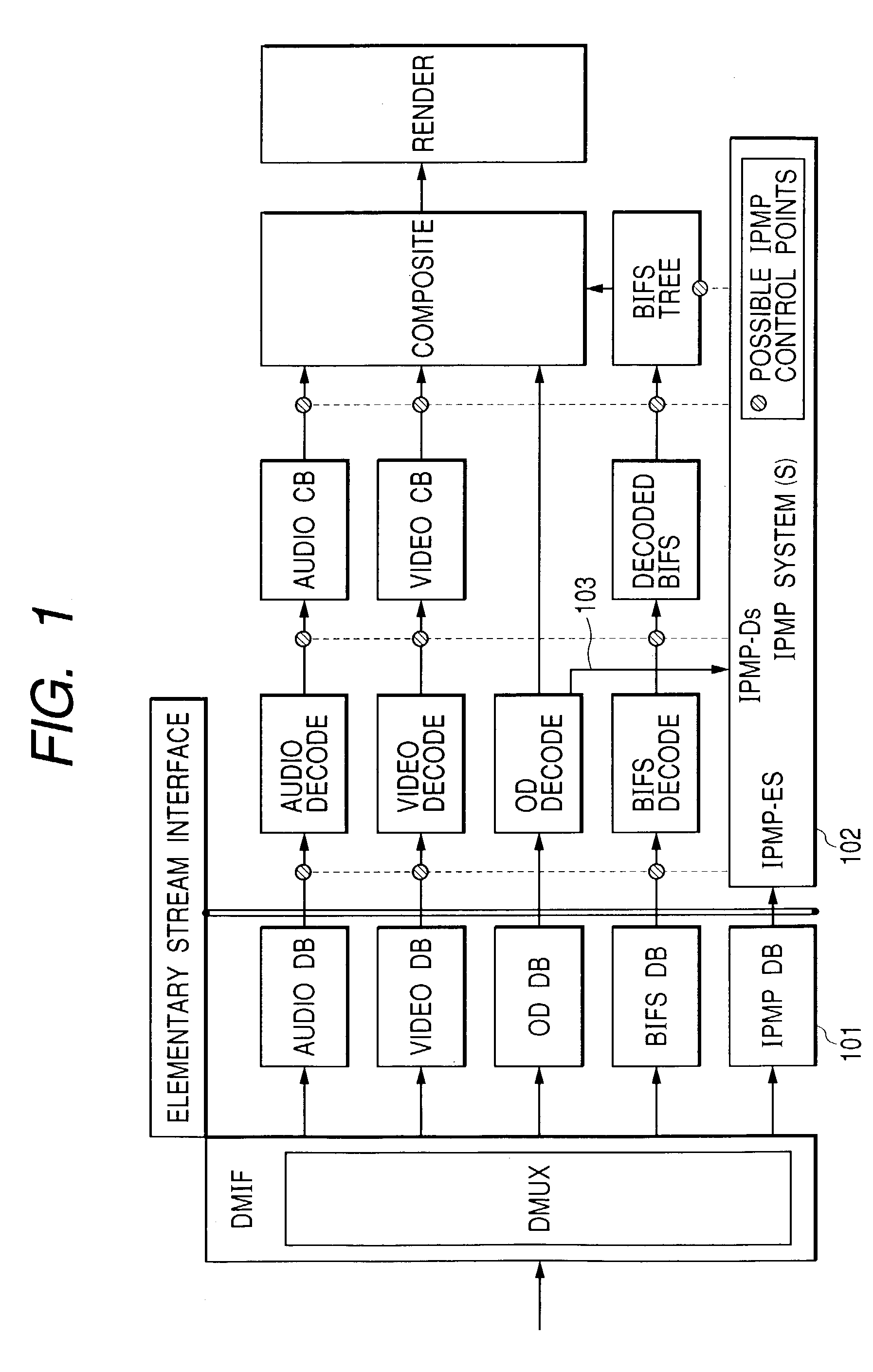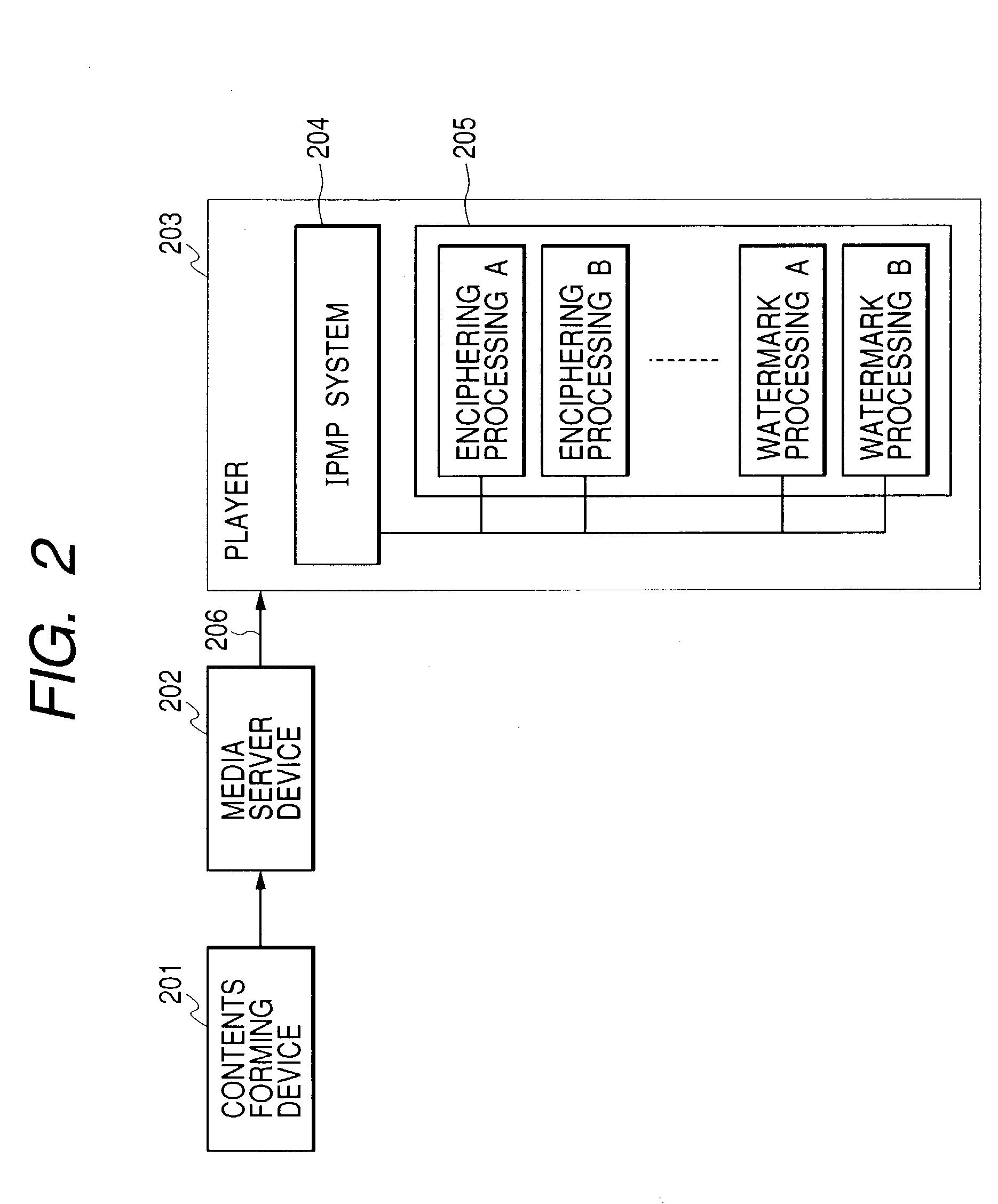Contents forming method and contents reproducing apparatus and method
a multimedia encoding system and reproducing method technology, applied in the field of content forming method, contents reproducing method and contents reproducing device of multimedia encoding system, can solve the problems of increased memory usage, decreased processing efficiency, and inconvenient runaway processing
- Summary
- Abstract
- Description
- Claims
- Application Information
AI Technical Summary
Benefits of technology
Problems solved by technology
Method used
Image
Examples
example 1
[0117]Explanation will now be made of a situation when, upon distributing the multi-media contents containing the IPMP message for performing the intellectual property rights management and protection, an error has occurred and the distributing side requests the error content of the error from the player 903 for performing contents reproduction.
[0118]At this time, the media server device 902, which is the distributing side, is waiting for transmission through the normal back channel. Further, the command 0x03 (=request_backward_message+request_error) is included in the IPMP message contained in the transmitted multi-media contents.
[0119]FIG. 11 is a flow chart showing a processing sequence in the case of exceptional processing.
[0120]First, the IPMP message containing the command “0x03” is added to the contents (step 1101). The contents that have been formed are the multi-media data having been protected by the IPMP system. The formed contents are transmitted as transmission data fro...
example 2
[0127]Explanation will now be made of an instance where the distributing side makes a request to the player 903 for performing contents reproduction for an IPMP system type that can be processed by the IPMP system having been built into the player in advance upon distribution of the multi-media contents containing the IPMP message for performing the intellectual property rights management and protection. This is one example of the IPMP Roaming Method mentioned above.
[0128]At this time, it is assumed here that the media server device 902, which is the distributing side, is waiting for the normal back channel transmission. Further, in order to simplify the explanation, errors are not considered here.
[0129]FIG. 12 is a flow chart showing a processing sequence in the case of a request for an IPMP system information notification.
[0130]First, the IPMP message containing the command for requesting the processable IPMP system type is generated (step 1201). In this example, the IPMP message ...
example 3
[0138]The IPMP message defined as the MPEG-4 version 1 standard (ISO / IEC 14496) and the IPMP system are premised upon providing the intellectual property rights management and protection system for specific reproduction of multi-media contents. The IPMP message and the protected objects, such as picture images and voice, are linked to each other by means of object descriptors, and control of these object descriptors is performed by the IPMP system. Therefore, it is possible for the IPMP system not to perform processing based on its own independent judgment, but it is impossible for the IPMP system to quit processing based on instructions from the contents.
[0139]In this example, an instance is explained in which a determination is made as to whether an error will occur or not, without performing processing to the contents.
[0140]In the IPMP message, 0x80 (=pseudo_message) is added to 0x03 (=request_backward_message+request_error), which was discussed in the first example, and thus bec...
PUM
| Property | Measurement | Unit |
|---|---|---|
| compatibility | aaaaa | aaaaa |
| OD | aaaaa | aaaaa |
| width | aaaaa | aaaaa |
Abstract
Description
Claims
Application Information
 Login to View More
Login to View More - R&D
- Intellectual Property
- Life Sciences
- Materials
- Tech Scout
- Unparalleled Data Quality
- Higher Quality Content
- 60% Fewer Hallucinations
Browse by: Latest US Patents, China's latest patents, Technical Efficacy Thesaurus, Application Domain, Technology Topic, Popular Technical Reports.
© 2025 PatSnap. All rights reserved.Legal|Privacy policy|Modern Slavery Act Transparency Statement|Sitemap|About US| Contact US: help@patsnap.com



